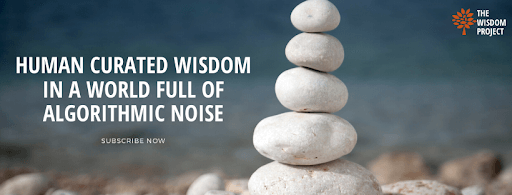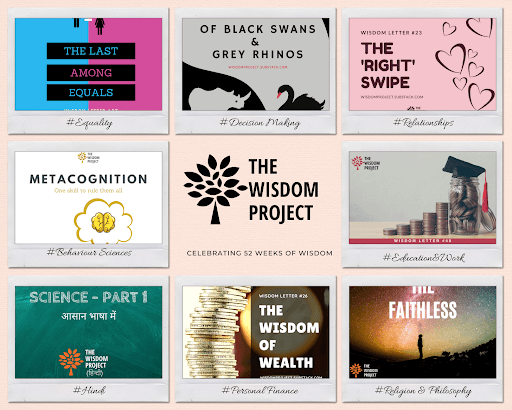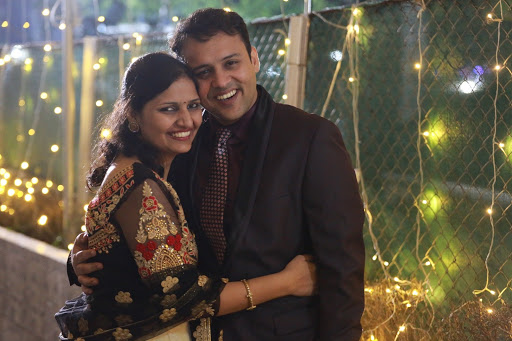Human Curated Wisdom in a World Full of Algorithmic Noise
Hi there! Who are you and what’s your background?
Hi, I am Ayush Chaturvedi. My wife Aditi and I are the creators of The Wisdom Project. We love reading about interesting ideas and opinions in the world, deconstructing them and then synthesizing them again in our own vision.
We are based out of New Delhi, India and our day jobs are in the tech industry here. I am an Android Developer and Aditi is a UX Designer/Product Manager.
Our newsletter is our side project that’s very close to our hearts. It started as a simple way to make our weekends more meaningful, but now after a year of doing it we realize that it has become a platform for us to express our interests and passions as well as a way for us to learn to think better about the world.
What’s The Wisdom Project about?
The Wisdom Project is a handcrafted weekly curation of the best online content around a particular topic. Every week we pick an interesting topic and we recommend the best articles, podcasts, videos, books to read around it. It helps us and our readers form a well rounded opinion about the concept.
We have sent out 52 editions of the newsletter, called Wisdom Letters.
Topics have ranged from climate change to personal finance, fitness and health to relationships and parenting, geopolitics to behavioral science.

We try to stay away from the toxic news cycle, but we don’t shy away from issues that matter. We have written about the Black Lives Matter movement in the US, and also the Caste problem in India. We also have had to lose a few subscribers because we raised these issues. But we will take it, we value our freedom to express our opinion a lot more and we appreciate the freedom of our readers to unsubscribe from content that doesn’t resonate with them.
We don’t try to tell our readers what they should think about a particular topic, rather how they should go about thinking about every topic.
For us, ‘Wisdom’ is an umbrella term to describe a general framework of thinking better and thinking critically about any and everything under and over the Sun.
And even though every week the topic we write about is different, the theme that runs through every post is quite similar. Our regular readers notice that and appreciate that a lot.
This approach has broadened our minds and perspectives on multiple issues and ideas. And that is the biggest benefit of this newsletter, it helps us and our readers_ _become better versions of ourselves.
Our intended audience is anyone who is looking to have a nuanced opinion on topics that matter, and who wishes to learn to form a well rounded and nuanced opinion. Anyone who is interested in becoming a better version of themselves, who wishes to think better, to think deeply and critically and who wants a good workout of their brain.
When did you get started writing The Wisdom Project? What motivated you to get started?
We have always loved to read. In the pre-internet era, we loved reading books as children during our school and college days. And with the arrival of the internet, now we started enjoying consuming all kinds of interesting and valuable non-fiction, non-bookish content as well. Be it blogs, podcasts, videos, newsletters, everything. This content added tremendous value to our quality of life, and we thought it would help our friends and family as well.
So we started writing this newsletter in September last year, and it started as a simple weekend project where we were sending a bunch of links to our friends about interesting content we thought they would love. And they did. They really enjoyed it.
But we soon realized that just sending out random content doesn’t add as much value and doesn’t help our readers learn a lot.
Without some context, it's very difficult for us humans to learn anything useful. Think back to your favorite childhood teachers. The best teachers were the ones who could weave stories around their subjects, because they knew that’s how we learn the best.
So we shifted to a format where we tried to build a narrative through the post and a common thread going across all our recommendations. We fumbled a lot with the storytelling part of it and are still learning the ropes. We have a long way to go in this area and our readers have been supportive and enjoy the narratives we try to build.
We had a framework now to write every week, and we loved it. The right constraints can become superpowers.

We write about a wide range of topics, and the choice of topics is usually around what is going in the world, or something we always wanted to read about but didn’t have the time. Or a friend suggests something and we like it, we go deep down rabbit holes around the topic and make our own inferences on it.
We try to cover every topic that has something to teach us and try to extract practical lessons from it that are applicable even outside the topic.
We have always liked writing. I think anyone who loves reading someday dreams of becoming a writer themselves. We had plenty of half-hearted attempts at blogs before this, but they didn’t survive long. With this project we gave ourselves the right structure to combine our love for reading as well as writing. I think that is the reason why we have been able to sustain it for a long period of time.
What does the process of writing your newsletter look like for you?
We send out a Wisdom Letter every Sunday. And the preparation for it starts a week before. So every Sunday we discuss and conclude on a topic for next week. Then we start to read widely around that topic. We read articles, listen to podcasts, watch videos on Youtube. We look for books related to it and try to read them if we haven’t already.
For 5 days we collect a wide range of content. We have a separate Whatsapp chat, with just the two of us on it, we dump all the links there so that both of us can go through all the content. We also have a shared Pocket account where we read articles and also rate them. So that ensures something goes in the newsletter only if both of us like it.
Sometime around Thursday or Friday we start finalizing on the links that we do want to share, from 15-20 pieces of content we narrow it down to 5 or 6. Then we start to build a narrative around these 5 or 6 pieces of content to see if all of them fit together. We remove anything that doesn’t fit.
By Saturday we have a fair idea of what the newsletter is going to look like, then we start writing. We write a short introduction, it usually contains a lot of questions. Questions that force the reader to think and help us set the context of the post.
Then we write a short piece of commentary on every piece of content. It's usually about what we liked the most from it and maybe some highlights. It's something that helps the reader feel intrigued about reading or watching that piece and also how it connects to the whole larger picture we are trying to paint.
We usually end with a quote related to the topic, our readers love these quotes. And summarize our understanding of the concept and give our readers something to think about.
We make illustrations of most pieces of content, as well as for the complete post and also for the quote at the end.
Once we are happy with how it has come out, we schedule it for delivery for Sunday morning 8 AM Indian Standard Time. (We haven’t missed a single Sunday in the last year.)
Tools we use: Pocket to save content, Whatsapp to collect, Youtube, Google Podcasts, Google search for content discovery, Canva to make illustrations and finally Substack to send out the newsletter.
What are some of the difficulties you’ve encountered in running your newsletter?
I think the biggest problem we face is ending up in the promotions tab. We don’t promote anything, we don’t try to sell anything, we genuinely want to deliver value to our readers. Yet Gmail puts us in the promotions tab quite often. We have had readers who have marked our mail as important, who have manually dragged our main in their primary inbox, and yet the next time our mail has ended up in promotions. We don’t know if it's a Substack problem or a Gmail problem. We are trying to fix that but there don’t seem to be clear ways to do that, because nobody seems to know why exactly it happens.
What have you learned through writing your newsletter?
People have a “critical thinking” problem. Critical thinking is basically objectively analyzing a topic or an issue from all sides, collecting data, and forming well rounded opinions on matters of importance. Some would say, that _is _thinking.
If that is not what you do with your mind then you’re not thinking, you’re just acting on impulse, getting nudged around by random external events.
As we wrote week after week on various topics, we realized that a lot many people don’t think deeply. They don’t practice critical thinking. We dove deep into topics and tried to bring out the complexity and nuance around the topics. And when we looked at the public debate around that topic we missed those most important nuanced opinions. Life is messy and complicated, as are most issues in the world. I think if people put in a bit more effort in going deep on a topic we would have a much more nuanced public discourse and much more peaceful society. Somehow this has evolved to be our mission statement over the past year.
What do you do outside of writing your newsletter?
Apart from our day jobs and the weekend newsletter, we love spending time with our family.
We have a 5 year old son, and my parents also live with us. We enjoy playing board games and card games together. We play a lot of Monopoly, Monopoly Deal, Ticket To Ride and Uno. We believe we can teach a lot to our son through playing games with him rather than Zoom classes that his school is doing. Especially during the lockdown, we have stayed away from online classes for him and engaged him more in practical ways of learning through games, puzzles, and also doing chores around the house. I think he is learning well.

What’s your favorite part about writing your newsletter?
The favorite part is the writing itself. I think writing is thinking. Penning down your thoughts really helps you clear your mind a lot. We throw away a lot of what we write because it doesn’t fit the narrative of the post, but even the stuff that we throw away helps us solidify our thoughts and learnings. So yeah, writing is the most valuable part for us.
What are some of your favorite newsletters, books, and podcasts?
Our favorite newsletter is James Clear’s 1-2-3 Thursdays, as he says, most wisdom per word in any newsletter.
Our favorite book is tough to pick, but Sapiens from Yuval Noah Harari is perhaps at the top. We are currently reading Superthinking by Gabriel Weinberg which is fascinating as well. It's about mental models and cognitive biases.
Our favorite blog is WaitButWhy from Tim Urban. I think he is a fantastic writer, his ability to explain complex topics in simple, entertaining ways is unmatched.
Our favorite podcast is The Knowledge Project from Shane Parrish of Farnam Street. I think they have wonderful guests and deep conversations. His interview with Naval Ravikant is one of my all time favorite podcasts. Something which had a deep impact on me and changed the way I looked at the world.
Where can readers go to learn more about you and your newsletter?
Readers can find the newsletter at wisdomproject.substack.com. We have a Facebook page for our newsletter where we try to share small byte size pieces of wisdom frequently.



